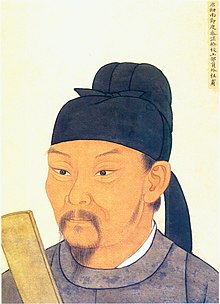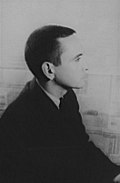Portal:The arts
T H E A R T S P O R T A L
The arts or creative arts are a vast range of human practices of creative expression, storytelling, and cultural participation. The arts encompasses multiple diverse and plural modes of thinking, doing, and being, in an extremely broad range of media. Both dynamic and a characteristically constant feature of human life, they have developed into innovative, stylized, and sometimes intricate forms. This is often achieved through sustained and deliberate study, training, and/or theorizing within a particular tradition, across generations, and even between civilizations. The arts are a vehicle through which human beings cultivate distinct social, cultural, and individual identities while transmitting values, impressions, judgements, ideas, visions, spiritual meanings, patterns of life, and experiences across time and space.
Prominent examples of the arts include: visual arts (including architecture, ceramics, drawing, filmmaking, painting, photography, and sculpting), literary arts (including fiction, drama, poetry, and prose), and performing arts (including dance, music, and theatre). They can employ skill and imagination to produce objects and performances, convey insights and experiences, and construct new environments and spaces.
The arts can refer to common, popular, or everyday practices as well as more sophisticated, systematic, or institutionalized ones. They can be discrete and self-contained or combine and interweave with other art forms, such as the combination of artwork with the written word in comics. They can also develop or contribute to some particular aspect of a more complex art form, as in cinematography. By definition, the arts themselves are open to being continually redefined. The practice of modern art, for example, is a testament to the shifting boundaries, improvisation and experimentation, reflexive nature, and self-criticism or questioning that art and its conditions of production, reception, and possibility can undergo.
As both a means of developing capacities of attention and sensitivity and as ends in themselves, the arts can simultaneously be a form of response to the world and a way that our responses and what we deem worthwhile goals or pursuits are transformed. From prehistoric cave paintings to ancient and contemporary forms of ritual to modern-day films, art has served to register, embody, and preserve our ever-shifting relationships to each other and to the world. (Full article...)
Featured articles -
Featured picture
Did you know...
- ... that the architects of the Florida Tropical House (pictured), located in Beverly Shores, Indiana designed the house with Florida residents in mind?
- ... that Lady Elsie Mackay, socialite, actress and interior designer, died in 1928 with WWI ace Walter G. R. Hinchcliffe, attempting to be the first woman to fly across the Atlantic?
- ... that author Laura Vernon Hamner, informally known as "Miss Amarillo", lived over thirty years in an Amarillo, Texas hotel?
In this month
- 9 June 1904 – The London Symphony Orchestra, conducted by Hans Richter, plays its first concert
- 18 June 1964 – Italian painter Giorgio Morandi, whose still lifes and landscapes were noted for their tonal subtlety, dies in Bologna at the age of 73
- 20 June 1703 – The Love Suicides at Sonezaki by Chikamatsu Monzaemon, often considered the greatest Japanese dramatist, receives its first performance
- 24 June 1924 – Efua Sutherland, a foundational figure in modern Ghanaian drama, is born in the Cape Coast region of Ghana
- 29 June 1861 – Elizabeth Barrett Browning (pictured), one of the most prominent poets of the Victorian era, dies in Florence at the age of 55
News
- August 5: DaBaby Levitating remix losing US radio audiences after the rapper's comments on HIV/AIDS
- June 11: Taylor Swift's Evermore records biggest sales week of the year as it returns to No 1 on album chart
- May 27: Olivia Rodrigo's song good 4 u debuts at No 1 on US Billboard Hot 100 chart
- May 25: 'Rock and roll never dies': Italy wins Eurovision after 30 years
- February 10: Disney to shut down Blue Sky Studios, animation studio behind 'Ice Age'
Featured biography
Abbas Kiarostami (born 1940) was an internationally acclaimed Iranian film director, screenwriter, photographer and film producer. An active filmmaker since 1970, Kiarostami has been involved in over forty films, including shorts and documentaries. Kiarostami attained critical acclaim for directing the Koker Trilogy (1987–94), Taste of Cherry (1997), and The Wind Will Carry Us (1999). Kiarostami has worked extensively as a screenwriter, film editor, art director and producer and has designed credit titles and publicity material. He is also a poet, photographer, painter, illustrator, and graphic designer. Kiarostami is part of a generation of filmmakers in the Iranian New Wave, a Persian cinema movement that started in the late 1960s and includes pioneering directors such as Forough Farrokhzad, Sohrab Shahid Saless, Mohsen Makhmalbaf, Bahram Beizai, and Parviz Kimiavi. These filmmakers share many common techniques including the use of poetic dialogue and allegorical storytelling dealing with political and philosophical issues. Kiarostami has a reputation for using child protagonists, for documentary style narrative films, for stories that take place in rural villages, and for conversations that unfold inside cars, using stationary mounted cameras. (Full article...)
Featured audio
Selected quote
Categories
WikiProjects
Parent project
Descendant projects
Related portals
Things you can do
- Check the recent changes page for improvements, other changes, and vandalism to these articles
- Article requests: Requests articles (arts and entertainment)
- Deletion discussions: Listed at Wikipedia:WikiProject Deletion sorting/Arts
- Expand: check Visual arts stubs to expand
- Notability: Articles with notability concerns, listed at WikiProject Notability
- Requested pictures: Arts topics, requested pictures






























